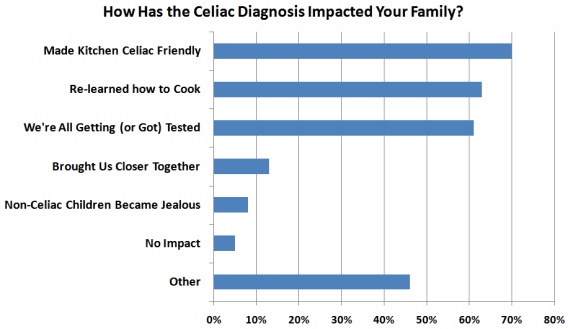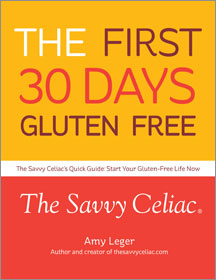Celiac disease is a bittersweet diagnosis isn’t it? You or your child has felt awful for so long now you finally get the answer: a life-long, gluten-free diet. Thoughts and emotions are very mixed. I remember one moment saying, “Well good! We know, she’ll get better, without medicine.” Later those thoughts went something like this….”A gluten-free diet will make her better….one that she’ll have to be on (gulp) forever….life-long – that’s a long time to be on a diet. Whew!” But somehow you buck up and get it done.
But while the celiac patient may be thinking this diet only affects him or her – that is not the case at all. In a February 2009 unscientific survey conducted by www.thesavvyceliac.com, parents talked about how their families’ lives changed with the gluten-free lifestyle when their child was diagnosed. Now while this was a survey among parents and their children, I am sure some of these answers are easily translated to an adult diagnosis.
Changing with (Gluten-Free) Times
The survey asked “How has the celiac diagnosis impacted your family?” Here are the answers.
In the Kitchen
The top two most popular answers take you directly into the kitchen. One of the things we all learn is that with the diet, our traditionally-stocked kitchen is no longer safe for our celiac family members to navigate. We have to quickly clean up the kitchen then get to the store. One of my first purchases was glass cutting boards. They are tough on knives but don’t leave any gluten-filled grooves around. I have since moved to plastic cutting boards dedicated to gluten-free foods. Some said they converted to a 100% gluten-free home.
Re-learning how to cook is another biggie – particularly in regards to cross-contamination. One respondent said, “The most difficult part is holidays- when I cook I make sure to serve only GF foods so there is no cross contamination on the table. People forget”. Another person said, “Re-learned how to bake, mostly. Most other cooking has only needed minor alterations.”
Others have made the cooking a positive experience. “Teen was the last to be diagnosed,” one respondent said, “…so she fell in-step with the rest of the family. We eat more together and cook together as it is important that the kids learn how to cook and recognize what is and isn’t safe.”
Testing, Grieving, other celiac survey results
A huge amount: 60% of folks got tested for celiac after the first diagnosis in their family came to light. From there, the answers are less populated. 37% said they grieved when they got the diagnosis, but as one person said, “…now it’s just second nature.” However there were a few answers that came in frustration, “It’s a huge pain in the ass,” one person said. Another said, “It made life harder overall.”
Eight percent agreed with the non-celiac jealousy issue. One respondent said she gets very frustrated “…trying to keep her [celiac] happy and the non GF family members happy too.” Another parent said, “I wouldn’t say my non-celiac son was jealous, but he pointed out after a while that I don’t buy the wheat things he likes, like Pop-Tarts. I found that this was also a disservice to my celiac son as I was protecting his feelings when they won’t be protected in the real world.”
A lot of people talked about the frustrations of going out and planning a meal at a restaurant, or always bringing a snack. Others said in support of the celiac(s) in their family they all went gluten-free and no one gripes about it. “We really ALL jumped on the bandwagon and went gluten-free at home.”
As we all know, the gluten-free diet – is not just a diet. It is a lifestyle and everyone in the house needs to accept whatever changes are made. Maybe your household goes 100% gluten-free. Maybe you don’t, but you educate everyone in your family about cross-contamination and the new rules that apply to everyone.
So what are some of those family strategies to help the family and the celiac in your life adapt to the gluten-free lifestyle? We’ll have more on that in a future post.
This survey also included research on the challenges of celiac tweens and teens which has already been published. Click here to read more on that post.




Leave a Reply